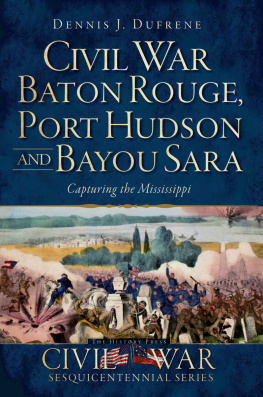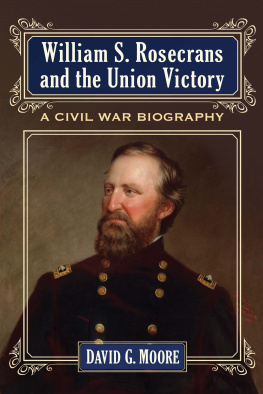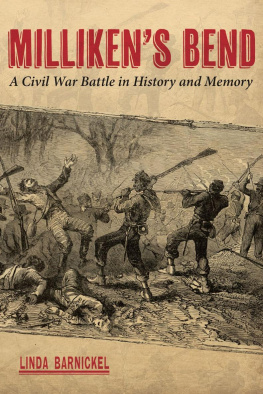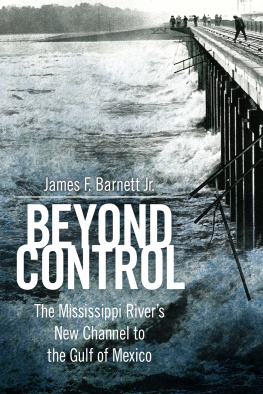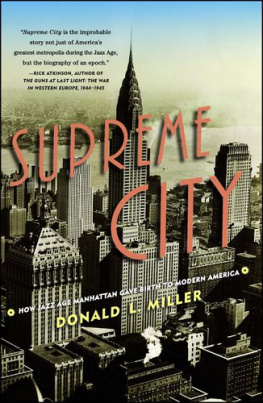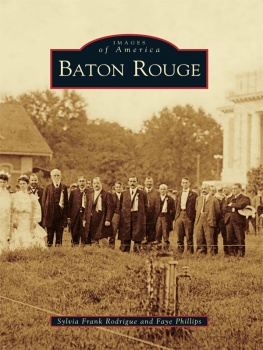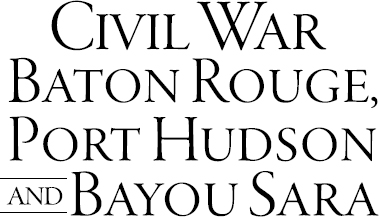
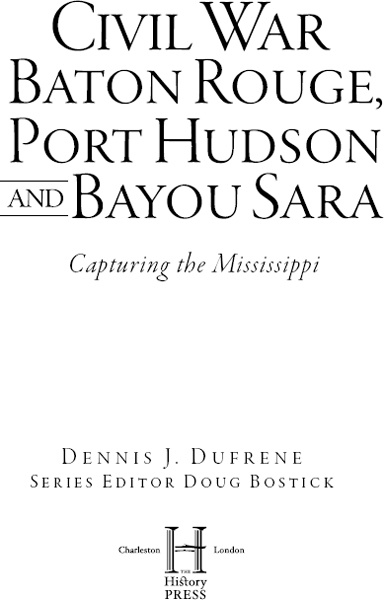
Published by The History Press
Charleston, SC 29403
www.historypress.net
Copyright 2012 by Dennis J. Dufrene
All rights reserved
Front cover: The Battle of Baton Rouge, La. August 4th, 1862. Published by Currier & Ives.
First published 2012
e-book edition 2012
ISBN 978.1.61423.359.6
Library of Congress Cataloging-in-Publication Data
Dufrene, Dennis J.
Civil War Baton Rouge, Port Hudson and Bayou Sara : capturing the Mississippi / Dennis
J. Dufrene.
pages cm
Includes bibliographical references and index.
print edition ISBN 978-1-60949-351-6
1. Louisiana--History--Civil War, 1861-1865--Campaigns. 2. Mississippi River Valley-History--Civil War, 1861-1865--Campaigns. 3. United States--History--Civil War, 1861-1865--Campaigns. 4. Baton Rouge (La.)--History--Siege, 1862. 5. Port Hudson (La.)-History--Siege, 1863. 6. Bayou Sara (La.)--History, Military--19th century. I. Title.
E474.1.D84 2012
973.73--dc23
2012001031
Notice: The information in this book is true and complete to the best of our knowledge. It is offered without guarantee on the part of the author or The History Press. The author and The History Press disclaim all liability in connection with the use of this book.
All rights reserved. No part of this book may be reproduced or transmitted in any form whatsoever without prior written permission from the publisher except in the case of brief quotations embodied in critical articles and reviews.
Dedicated to
Tweety & Myles
This book would not have been possible without their help and understanding.
Contents
Acknowledgements
I would like to thank the Louisiana State Historic Sites, in particular, Audubon State Historic Site and Port Hudson State Historic Site, for their time and effort. The staff at each site was a wealth of knowledge that was crucial to the completion of this book.
I would like to give a special thank-you to my family for their support and understanding. Without them, none of this would have been possible.
Introduction
The Civil War has been noted as the bloodiest war in American history, and rightfully so. Historians estimate that the War Between the States claimed the lives of more than 600,000 men, women and children. The Union and the Confederates faced each other more than ten thousand times over the course of four years. After each battle, skirmish and engagement, the surrounding landscape was scarred, never to be the same again. This scarring of the American landscape definitely holds true in the South, where most of the fighting took place.
Scores of books, articles and essays have been written to study and describe this nation-shaping event. Thousands of volumes lay on bookshelves that go into great detail on key battles such as the First Battle of Bull Run, Antietam, Shiloh and Gettysburg. There is not an author or historian alive who would disagree with the idea that if any of these key battles ended differently, the American Civil War could have had a vastly different outcome. Though these battles were important, the fate of the Civil War was not decided on these few battles alone.
The Civil War was made up of thousands of battles, though some were no larger than a skirmish. Each of these battles carried its own weight, contributing to the final outcome in its own way. Union and Confederate armies clashed all across the country, fighting in nooks and crannies sometimes not even big enough to warrant a name. This was definitely the case when the blue and gray went up against each other in Louisiana.
The two sides met on the field of battle throughout Louisiana at least twenty-three times over the four-year span of the war. Most of these battles or engagements were fought along the Mississippi River and the Red River. However, the Atchafalaya Basin and Bayou Lafourche had a considerable amount of action as well. Both the Confederacy and the Union realized that if either side controlled the waterways (and there were many), they could effectively control the state.
This was not to imply that Louisiana did not have any railroads. The state actually had twelve railroad companies that boasted several extensive lines and an array of smaller, rural ones. All in all, the companies had built nearly four hundred miles of track throughout the state. The most famous of the lines were the New Orleans, Jackson and Great Northern Railroad and the New Orleans, Opelousas and Great Western Railroad. Because of their strategic locations, the North and South were constantly vying for their control. These railroads were the pinnacle of transportation in their heyday. Besides the river, the railroad was the most efficient way to move men and supplies great distances, a fact that the rail men were proud to advertise. In 1861, a common advertisement for the New Orleans, Jackson and Great Northern Railroad read: Two passenger trains leave the depot, at the corner of Callipe and Magnolia streets dailythe mail train at 7 a.m. and the Express train at 7 p.m. Connections made with all the Northern and Eastern roads and tickets sold to all the principle cities, North East and West.
The ad also boasted that it was the quickest way to travel. Not only could you reach any major city in the country from the New Orleans, Jackson and Great Northern Railroad, but you could get there in record time. In 1861, it only took three days and sixteen hours to reach New York City.
Therefore, it is not any wonder that as the war loomed, the Confederacy began to utilize the rails extensively. And because of this extensive use, the railroad also became a target. The railroad was attacked many times. Colonel Clark Wright described one of these attacks in great detail: I took out 1 miles of wire, and burned it on top of three bridges I destroyed. I cut the road by tearing up the rails at three points. I burned out one culvert, and warped the rails materially at two points by building large fires on them. In the aggregate 1 miles of road is destroyed and will require at least five or six days to repair it.
Another set of railroads, not as famous at the Great Northern or the Great Western, was the West Feliciana Railroad. The line was the first standard-gauge railroad built in the nation and spanned from Bayou Sara to Woodville, Mississippi. The railway was used primarily to transport cotton to and from the port in Bayou Sara to Woodville, which at the time was a major cotton hub in the South. The railroads builder, Edward McGehee, said that traveling along Louisianas dirt roads was easy for a bird, practicable for a mule, but impossible for anything else. These railroads held a significant strategic value for transporting goods and troops, but they were only supplements to the vast network of waterways. This is especially true for the Mississippi River, which was the main thoroughfare into the nations interior.
However, controlling the Mississippi River and the vast network of smaller waterways would be no easy task for either the Rebels or the Yankees. From the time it was a colony through the Civil War, Louisiana was known for its maze of rivers, lakes, bays and bayous. For decades, smugglers and pirates used the elusive waterways to traffic contraband and hide from authorities. Oftentimes, when Louisiana slaves would run away, they would hide in the dense wilderness, knowing that the swamps could easily conceal their presence. Unfortunately for these explorers, navigators, slaves and pirates, that wilderness was unforgiving. Many died along the rivers and bayous, especially when they were not prepared to deal with such a harsh environment.
Next page
